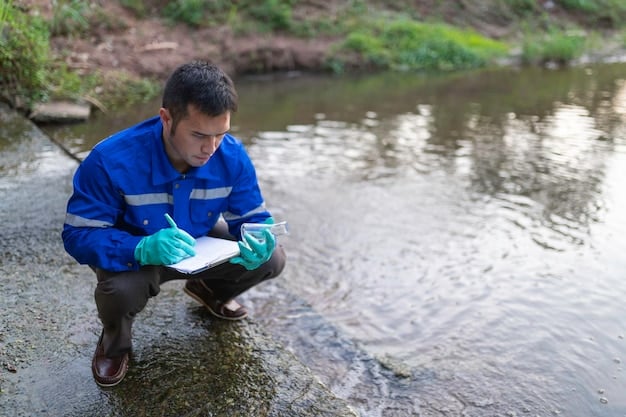Public Health & Environmental Safety: Protecting Communities

Public health and environmental health are intertwined disciplines focused on protecting communities from environmental hazards through research, policies, and interventions that mitigate risks and promote well-being.
Public health and environmental health play critical roles in safeguarding communities from an array of environmental hazards. Understanding the intersection of these fields is essential for creating effective strategies to mitigate risks, promote well-being, and ensure healthier, safer environments for all.
Understanding Public Health and Environmental Health
Public health and environmental health are distinct yet interconnected fields, both dedicated to protecting human health and well-being. Public health encompasses a broad range of activities aimed at preventing disease and promoting health at the population level, while environmental health focuses specifically on the impact of environmental factors on human health.
Defining Public Health
Public health involves organized efforts to prevent disease, prolong life, and promote health through various interventions, including health education, disease prevention programs, and policy development. It addresses health issues at the community, national, and global levels.
Defining Environmental Health
Environmental health addresses the impact of environmental factors on human health and disease. This includes physical, chemical, and biological factors, as well as related ecosystem.

Understanding the differences and overlaps between public health and environmental health is crucial for developing comprehensive strategies to protect communities from environmental hazards. Addressing both the broader public health context and specific environmental factors ensures a more effective and holistic approach to health protection.
- Public Health Focus: Population-level health, disease prevention, and health promotion.
- Environmental Health Focus: Environmental factors impacting human health, including air, water, and soil quality.
- Overlapping Goals: Protecting communities from health risks and promoting well-being.
- Collaborative Efforts: Integrated strategies for addressing complex health issues.
In conclusion, public health and environmental health are complementary fields that work together to safeguard communities from environmental hazards. A comprehensive understanding of both disciplines is essential for creating effective interventions and policies that promote healthier, safer environments for all.
Key Environmental Hazards Impacting Public Health
Environmental hazards pose significant threats to public health, affecting air and water quality, food safety, and overall community well-being. Identifying and mitigating these hazards is crucial for protecting vulnerable populations and preventing disease.
Air Pollution
Air pollution is a major environmental hazard, with both outdoor and indoor sources contributing to respiratory illnesses, cardiovascular diseases, and other health problems. Common pollutants include particulate matter, ozone, nitrogen dioxide, and sulfur dioxide.
- Sources of Air Pollution: Industrial emissions, vehicle exhaust, construction activities, and indoor sources like smoking and burning fossil fuels.
- Health Impacts: Respiratory infections, asthma exacerbation, cardiovascular disease, and lung cancer.
- Mitigation Strategies: Implementing stricter emission standards, promoting cleaner transportation options, and improving indoor ventilation.
Water Contamination
Water contamination poses a serious risk to public health, as contaminated water can transmit infectious diseases, introduce harmful chemicals, and lead to chronic health conditions. Common contaminants include bacteria, viruses, parasites, heavy metals, and pesticides.
Protecting our water resources can prevent devastating diseases and create better health conditions.

- Sources of Water Contamination: Industrial discharge, agricultural runoff, sewage leaks, and inadequate water treatment.
- Health Impacts: Waterborne diseases (e.g., cholera, typhoid fever), chemical poisoning, and developmental problems.
- Mitigation Strategies: Improving water treatment processes, regulating industrial discharge, and implementing agricultural best management practices.
Addressing key environmental hazards such as air pollution and water contamination requires a multi-faceted approach involving policy changes, technological innovations, and community engagement. By implementing effective mitigation strategies, we can protect public health and create healthier, more sustainable environments for current and future generations.
Vulnerable Communities and Environmental Inequities
Environmental inequities disproportionately affect vulnerable communities, leading to significant health disparities. These inequities often stem from historical and systemic factors that place certain populations at higher risk of exposure to environmental hazards.
Defining Environmental Justice
Environmental justice is the fair treatment and meaningful involvement of all people regardless of race, color, national origin, or income, with respect to the development, implementation, and enforcement of environmental laws, regulations, and policies.
Factors Contributing to Environmental Inequities
The causes of environmental inequities are complex and multifaceted, involving economic, social, and political factors that perpetuate disparities in environmental exposures and health outcomes.
Environmental inequities lead to pollution-related physical and mental health burdens.
- Socioeconomic Status: Low-income communities often live near industrial facilities and other sources of pollution due to affordability and zoning regulations.
- Racial Discrimination: Historically marginalized communities face discriminatory policies that concentrate environmental hazards in their neighborhoods.
- Lack of Political Power: Vulnerable populations may lack the resources and political influence to advocate for environmental protection and equitable policies.
Addressing environmental inequities requires a comprehensive approach that includes community engagement, policy reforms, and targeted interventions to reduce environmental exposures and promote health equity. By prioritizing environmental justice, we can create healthier, more equitable communities for all.
Public Health Initiatives for Environmental Protection
Public health initiatives play a crucial role in protecting communities from environmental hazards through various interventions, including monitoring environmental quality, implementing preventive measures, and promoting community education.
Environmental Monitoring Programs
Environmental monitoring programs are essential for assessing environmental quality, identifying potential hazards, and tracking the effectiveness of interventions. These programs involve collecting and analyzing data on air, water, soil, and other environmental media.
Preventive Measures and Policies
Preventive measures and policies are critical for reducing exposure to environmental hazards and preventing disease. These include regulations, standards, and best practices aimed at controlling pollution, promoting safe practices, and protecting vulnerable populations.
These initiatives help communities control pollution and create safer living conditions.
- Air Quality Regulations: Setting emission standards for industrial facilities and vehicles to reduce air pollution.
- Water Quality Standards: Establishing safe drinking water standards and regulating wastewater discharge to protect water resources.
- Land Use Planning: Implementing zoning regulations to separate residential areas from industrial facilities.
Implementation of preventive measures and environmental protection policies can drastically improve public health outcomes.
Public health initiatives are essential for protecting communities from environmental hazards through monitoring, preventive measures, and community engagement. By working together, we can create healthier, more sustainable environments for all.
The Role of Government and Community Engagement
Effective environmental health protection requires collaboration between government agencies, community organizations, and individual citizens. Government agencies provide the regulatory framework and resources needed to address environmental hazards, while community engagement ensures that policies and programs are responsive to local needs and priorities.
Government Regulations and Enforcement
Government regulations and enforcement mechanisms are critical for ensuring compliance with environmental laws and standards. These include permitting, monitoring, inspections, and enforcement actions to address violations and protect public health.
Community Involvement and Education
Community involvement and education are essential for promoting awareness, empowering individuals, and fostering collective action to address environmental hazards. This includes engaging community members in decision-making processes, providing access to information, and supporting community-led initiatives.
- Public Hearings: Providing opportunities for community members to voice their concerns and opinions on environmental issues.
- Educational Programs: Offering workshops, seminars, and outreach events to educate the public on environmental health risks and preventive measures.
- Community-Based Monitoring: Involving community members in environmental monitoring activities to collect data and identify potential hazards.
Collaboration between government and community is essential for developing effective solutions to complex environmental health problems. When government agencies and community organizations work together, they can leverage their respective strengths and resources to achieve shared goals and create healthier, more sustainable communities.
Future Directions in Public and Environmental Health
Advancements in technology, data analytics, and collaborative approaches are shaping the future of public and environmental health. These innovations hold the potential to enhance our ability to detect, prevent, and respond to environmental hazards and improve health outcomes for all.
Technological Innovations
Technological innovations are transforming the field of environmental health, offering new tools and methods for monitoring environmental quality, assessing health risks, and implementing effective interventions.
Data Analytics and Predictive Modeling
Data analytics and predictive modeling are playing an increasingly important role in public and environmental health, allowing us to analyze large datasets, identify patterns and trends, and forecast future health risks.
Using data can prepare cities for future risks.
- Disease Surveillance: Analyzing health data to detect outbreaks and track the spread of infectious diseases.
- Exposure Assessment: Using environmental monitoring data to estimate population exposure to pollutants and other hazards.
- Risk Mapping: Creating maps that identify areas with high levels of environmental risk and vulnerable populations.
Embracing technological innovations and data-driven approaches will be essential for advancing public and environmental health in the years to come. By leveraging the power of technology and data, we can create more effective strategies to protect communities from environmental hazards and promote health worldwide.
| Key Concept | Brief Description |
|---|---|
| 🌱 Environmental Health | Focuses on environmental factors affecting human health, like air and water quality. |
| 🛡️ Public Health Initiatives | Monitors environmental quality and implements preventive measures to protect community health. |
| ⚖️ Environmental Justice | Ensures fair environmental protection for all, especially vulnerable communities. |
| 📊 Data Analytics | Using data analysis to identify and address public health risks effectively. |
Frequently Asked Questions
▼
Environmental health aims to protect human health by mitigating environmental hazards through research, policy development, and interventions targeting air, water, and soil quality.
▼
Air pollution contributes to respiratory illnesses and cardiovascular diseases by introducing harmful particles and gases into the air, leading to chronic health conditions.
▼
Common water contaminants include bacteria, viruses, parasites, heavy metals, and pesticides, which can cause waterborne diseases and chronic health problems.
▼
Environmental justice ensures that all people, regardless of race or income, are fairly treated and involved in the creation and enforcement of environmental laws and regulations.
▼
Communities can participate through public hearings, educational programs, and community-based monitoring, helping to voice concerns, learn about risks, and collect valuable environmental data.
Conclusion
The intersection of public health and environmental health is critical for protecting communities from environmental hazards. Through research, policy, and community engagement, proactive measures can be implemented to mitigate risks and promote healthier communities.





